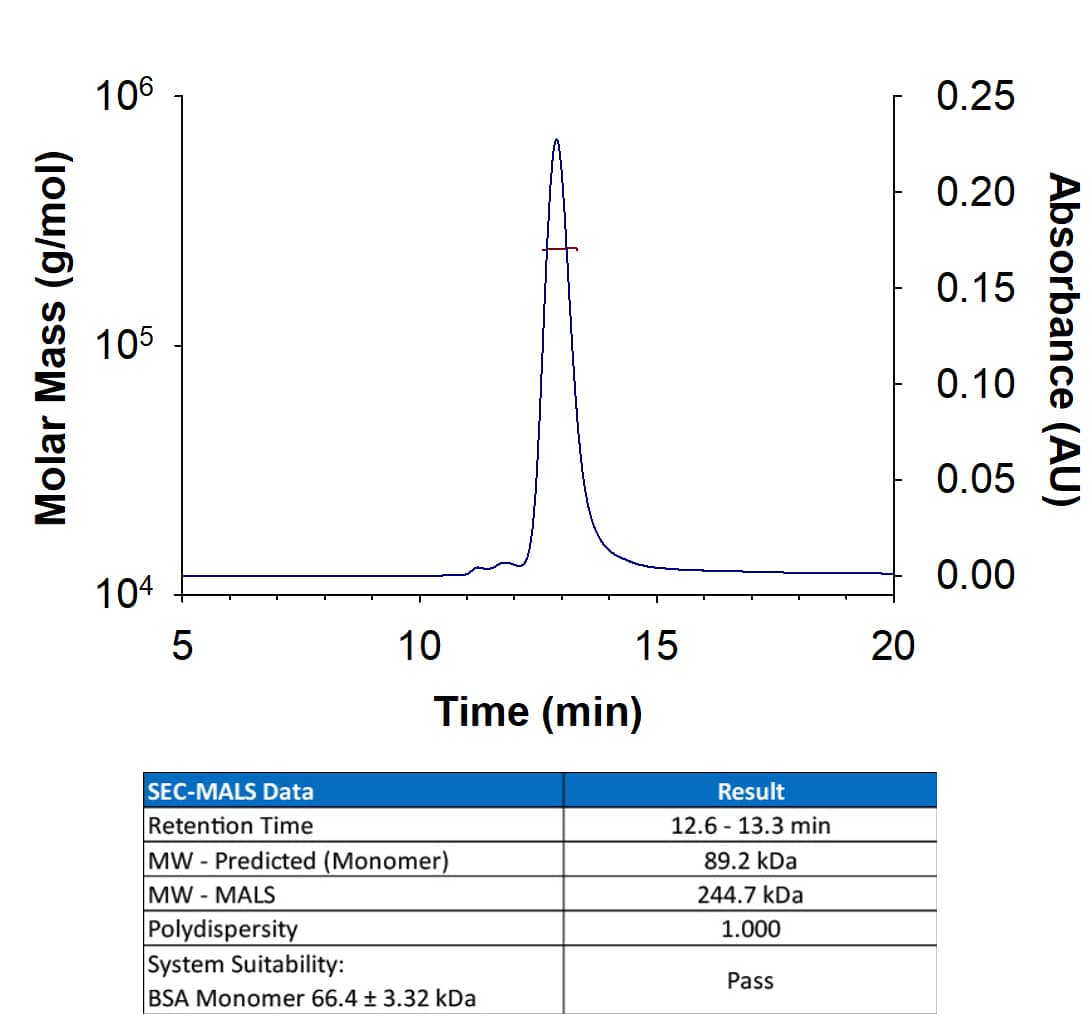Recombinant Human N-Cadherin Fc Chimera Protein, CF
R&D Systems, part of Bio-Techne | Catalog # 1388-NC
Analyzed by SEC-MALS

Key Product Details
Source
NS0
Accession #
Structure / Form
Disulfide-linked homodimer
Conjugate
Unconjugated
Applications
Bioactivity
Product Specifications
Source
Mouse myeloma cell line, NS0-derived human N-Cadherin protein
| Human N-Cadherin Asp160-Ala724 Accession # P19022.4 |
IEGRMD | Human IgG1 (Pro100-Lys330) |
6-His tag |
| N-terminus | C-terminus | ||
Purity
>90%, by SDS-PAGE visualized with Silver Staining and quantitative densitometry by Coomassie® Blue Staining.
Endotoxin Level
<1.0 EU per 1 μg of the protein by the LAL method.
N-terminal Sequence Analysis
Asp160
Predicted Molecular Mass
89.2 kDa (monomer)
SDS-PAGE
115‑130 kDa, reducing conditions
Activity
Measured by the ability of the immobilized protein to support the adhesion of U-118-MG human glioblastoma/astrocytoma cells.
Recombinant Human N-Cadherin Fc Chimera immobilized at 10 µg/mL, 100 µL/well, will induce ≥55% cell adhesion.
Optimal dilutions should be determined by each laboratory for each application.
Recombinant Human N-Cadherin Fc Chimera immobilized at 10 µg/mL, 100 µL/well, will induce ≥55% cell adhesion.
Optimal dilutions should be determined by each laboratory for each application.
Scientific Data Images for Recombinant Human N-Cadherin Fc Chimera Protein, CF
Recombinant Human N‑Cadherin Fc Chimera Protein SEC-MALS.
Recombinant Human N-Cadherin Fc Chimera (Catalog # 1388-NC) has a molecular weight (MW) of 244.7 kDa as analyzed by SEC-MALS, suggesting that this protein is a homodimer. MW may differ from predicted MW due to post-translational modifications (PTMs) present (i.e. Glycosylation).Formulation, Preparation and Storage
1388-NC
| Formulation | Lyophilized from a 0.2 μm filtered solution in Tris-Citrate. |
| Reconstitution |
Reconstitute at 100 μg/mL in sterile, deionized water containing 2 mM calcium 24 hours prior to use.
|
| Shipping | The product is shipped at ambient temperature. Upon receipt, store it immediately at the temperature recommended below. |
| Stability & Storage | Use a manual defrost freezer and avoid repeated freeze-thaw cycles.
|
Background: N-Cadherin
(MMP‑7) (12, 13). Aberrant cell surface expression of the pro and mature forms of N-Cadherin in cancer results in increased tumor progression and invasiveness (14, 15). N-Cadherin also mediates the adhesion between hematopoeitic progenitor cells and mesenchymal stromal cells of the bone marrow (16).
References
- Pokutta, S. and W.I. Weis (2007) Annu. Rev. Cell Dev. Biol. 23:237.
- Gumbiner, B.M. (2005) Nat. Rev. Mol. Cell Biol. 6:622.
- Reid, R.A. and J.J. Hemperly (1990) Nucleic Acids Res. 18:5896.
- Wanner, I.B. and P.M. Wood (2002) J. Neurosci. 22:4066.
- Benson, D.L. and H. Tanaka (1998) J. Neurosci. 18:6892.
- Saglietti, L. et al. (2007) Neuron 54:461.
- Reiss, K. et al. (2005) EMBO J. 24:742.
- Malinverno, M. et al. (2010) J. Neurosci. 30:16343.
- Jang, Y.-N. et al. (2009) J. Neurosci. 29:5974.
- Uemura, K. et al. (2006) Neurosci. Lett. 402:278.
- Hartland, S.N. et al. (2009) Liver Int. 29:966.
- Williams, H. et al. (2010) Cardiovasc. Res. 87:137.
- Dwivedi, A. et al. (2009) Cardiovasc. Res. 81:178.
- Maret, D. et al. (2010) Neoplasia 12:1066.
- Tanaka, H. et al. (2010) Nat. Med. 16:1414.
- Wein, F. et al. (2010) Stem Cell Res. 4:129.
Long Name
Neural Cadherin
Alternate Names
Cadherin-2, CD325, CDH2, NCadherin
Gene Symbol
CDH2
UniProt
Additional N-Cadherin Products
Product Documents for Recombinant Human N-Cadherin Fc Chimera Protein, CF
Product Specific Notices for Recombinant Human N-Cadherin Fc Chimera Protein, CF
For research use only
